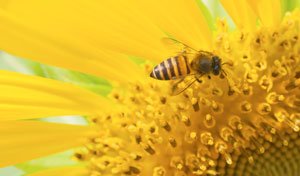"Bee" aware of stinging insect allergy
Mary Keating, MD
CentraCare Clinic - Health Plaza Allergy & Asthma
 Bees play a vital part in helping plants and flowers grow, but many of us would rather they mind their own “buzz-ness.”
Bees play a vital part in helping plants and flowers grow, but many of us would rather they mind their own “buzz-ness.”
It’s possible to get stung by honeybees, wasps, hornets and yellow jackets once spring arrives. But bees can become particularly aggressive in the late summer and fall because they are preparing for winter and their food is in short supply.
If you or your child get stung most likely you will experience pain, redness and swelling around the sting area. In this case, remove the stinger (if there is one), apply an ice pack and take an over-the-counter painkiller — if needed. Some people experience swelling that extends beyond where they got stung, and this swelling can last for 2 to 3 days. These are all normal reactions.
Symptoms of a systemic allergic reaction to bee stings
- Hives
- Itchiness and swelling in areas away from the sting site
- Flushed skin
- Swelling of the tongue or difficulty swallowing
- Stomach cramping, vomiting, nausea or diarrhea
- Difficulty breathing
- Dizziness or a drop in blood pressure
- Unconsciousness
- Anaphylaxis, which is a severe life-threatening reaction. This can occur within minutes of a sting. Epinephrine (adrenaline) should be given immediately and emergency medical care is needed immediately — call 911.
However, for one percent of kids and three percent of adults, a bee sting can result in a reaction where our body overreacts. This is a systemic allergic reaction, which may include any of the symptoms on the right. A systemic allergic reaction can be serious. Anyone who experiences difficulty breathing, problems swallowing, dizziness or a loss of consciousness should get immediate medical help.
If a child gets hives and swelling after getting stung – it’s generally not considered serious. But in adults, hives and swelling can be serious. It’s estimated that 30 to 40 percent of adults will have a systemic reaction to a bee sting if they previously developed hives from a sting. These adults should work with an allergist to confirm if they have a bee sting allergy.
Sadly, approximately 40 deaths occur per year in the U.S. due to bee sting reactions. Here are a couple facts to keep in mind about bee sting reactions:
- Bee sting reaction is different in every person and each person responds differently to each incident. Just because you have been stung by a bee before and didn’t have a serious reaction doesn’t mean that you won’t. It is possible for your body not to develop an allergic reaction until you’ve been stung several times.
- If you are worried you may be allergic to bee stings, talk to your health care provider. Depending on your history, you may be referred to an allergist who can perform skin or blood tests to venom — if appropriate.
- If a bee sting allergy is confirmed, an allergist can provide you with a prescription for epinephrine. The allergist will also discuss if you would benefit from bee sting venom allergy shots.
- Bites from fire ants can also cause similar reactions as bee stings. Fire ants are not native to Minnesota. However, those who are allergic to bee stings should be aware of fire ant mounds when travelling to the southern U.S.